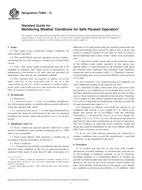Potřebujeme váš souhlas k využití jednotlivých dat, aby se vám mimo jiné mohly ukazovat informace týkající se vašich zájmů. Souhlas udělíte kliknutím na tlačítko „OK“.
ASTM F2993-13
Standard Guide for Monitoring Weather Conditions for Safe Parasail Operation (Withdrawn 2015)
Automaticky přeložený název:
Standardní Příručka pro sledování povětrnostních podmínek pro bezpečné parasail provozu (Withdrawn 2015 )
NORMA vydána dne 1.4.2013
Informace o normě:
Označení normy: ASTM F2993-13
Poznámka: NEPLATNÁ
Datum vydání normy: 1.4.2013
Kód zboží: NS-54824
Počet stran: 3
Přibližná hmotnost: 9 g (0.02 liber)
Země: Americká technická norma
Kategorie: Technické normy ASTM
Anotace textu normy ASTM F2993-13 :
Keywords:
parasail, weather conditions, weather log, weather-monitoring device, ICS Number Code 97.220.40 (Outdoor and water sports equipment)
Doplňující informace
| Significance and Use |
|
3.1 Every commercial parasail operator shall have a hard mount or handheld visual weather monitoring device. VHF alone is not acceptable. 3.2 Each vessel Master shall maintain a weather log in accordance with the procedures in Section 3.3 Wind Conditions: 3.3.1 Commercial parasailing is prohibited when the current observed wind conditions in the area of operation include a sustained wind speed of more than 20 mph, wind gusts of a difference of 15 mph greater than the sustained wind speed, the wind speed during gusts exceed 25 mph or rain or heavy fog results in reduced visibility of less than 0.5 mile, or when a known lightning storm comes within 7 miles of the parasailing area. 3.3.2 Hawaiian Islands region: due to the consistent nature of the offshore trade winds, operators in this region may operate under a 5 mph allowance to the sustained wind speed for offshore wind conditions only. Onshore wind conditions remain the same in accordance with 3.3.1. Therefore, commercial parasailing may occur in sustained offshore wind speeds up to 25 mph. 3.4 Sea Conditions—It is understood that sea conditions can cause additional loading of the parasail tow line. 3.4.1 Operators in lakes, intercoastal areas, and rivers shall not operate in sea conditions or a wave height that exceed 3 ft. Attention should be given to the specific body of water in these cases as these locations are typically protected areas. Therefore a wave height or water surface condition that meets or exceeds 3-ft waves or chop may be produced by wind that exceeds the 20 mph threshold described in 3.3. 3.4.2 Operators in offshore areas shall not operate in sea conditions that exceed a wave height of 4 ft, unless wave height and period are in accordance with the following calculation: 3 s of period for every 1 ft of wave height (for example, 4 ft = 12 s, 5 ft = 15 s, etc.). Wind speed and payload shall also be taken into consideration at all times of operation. The best evidence of wind and wave conditions within the flying area shall be determined by the vessel Master and may differ from a weather service report. 3.5 In no case shall parasail operations be conducted in weather conditions that exceed the manufacturer's specified limitations of the equipment being used. |
| 1. Scope |
|
1.1 This guide covers monitoring weather conditions for safer parasail operation. 1.2 This guide details parasail operators having weather-monitoring devices and keeping a weather log on board their vessels. 1.3 Units—The values stated in inch-pound units are to be regarded as standard. The values given in parentheses are mathematical conversions to SI units that are provided for information only and are not considered standard. 1.4 This standard does not purport to address all of the safety concerns, if any, associated with its use. It is the responsibility of the user of this standard to establish appropriate safety and health practices and determine the applicability of regulatory limitations prior to use. |
Odebírejte informace o nově vydaných normách ZDARMA:
Chcete pravidelně odebírat informace o nově vycházejících normách z celého světa a to zcela zdarma?
Přihlašte se k odběru. Vše je velice jednoduché a absolutně ZDARMA.
Na výběr máte vydavatele z celého světa.




 Cookies
Cookies
